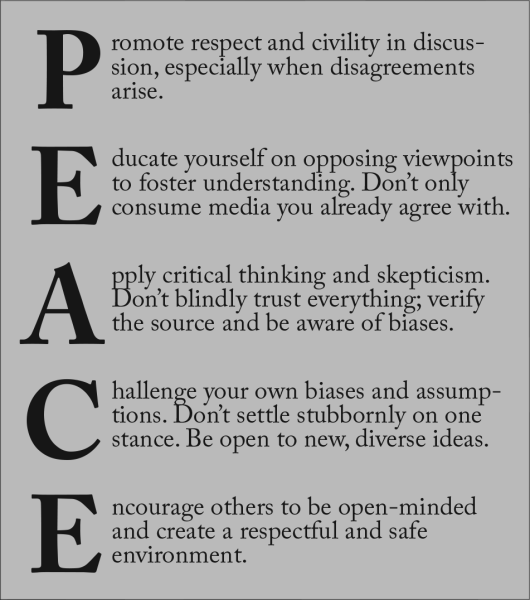With the 2024 presidential election nearing, I’m caught in the midst of a tornado of media coverage, heated debates and contentious online politics. As the unending stream of politics sweeps me up and carries me away, I find myself asking the same questions over and over again: Who can I trust? How can I spot misinformation? How can we discuss politics respectfully? These questions can be answered in three parts: what information we consume, how we synthesize it and how we express our opinions.
Consuming Media
It’s almost impossible to understand current politics without reading, watching or listening to the news. But with countless options available, how do we know which one has the most accurate, trustworthy and unbiased coverage?
Truth be told, every news outlet, journalist and article have different biases, which can cloud the truth. In the recent presidential debate, for instance, CNN might tell you Vice President Kamala Harris won fair and square, while Fox News may assert former President Donald Trump was victorious despite unfair treatment from ABC moderators.
For some, scouring the web for the needle of absolute objectivity in the haystack of journalism may be worth the time. However, even if you manage to find the most unbiased news out there, certain practices present in all media can still influence your thinking in other ways.
When covering election polls and predictions, for example, the media often utilizes terms such as “young voters,” “Catholic voters” or “Black voters” to group voters based on certain shared traits. This type of voter analysis, also called voter segmentation, is useful for understanding voter trends and catering political campaigns towards certain groups.
At the same time, excessive use of these buzzwords can stereotype groups who might not all vote the same way and pressure those without strong existing opinions to vote in ways that conform to these stereotypes.
So, how can we combat media bias without spending hours sifting through dozens of articles to extract the purest stories? One method is to use a website like AllSides, which compiles news coverage from all sides of the political spectrum — left, right and center — and cautions about media biases with bias ratings.
If I’m being honest, though, changing how I get my news is easier said than done. But even if you’re anything like me, there’s no need to worry. Simply being aware of which way our favorite media outlets tend to lean and being skeptical of articles that sound a bit too opinionated is enough.
Forming Opinions
No matter what political beliefs one has, many people agree modern politics has become too polarized. In the recent presidential and vice presidential debates, both candidates spent a huge amount of time attacking the other side instead of pitching how their own policies could help solve America’s most pressing problems. Specifically, Harris and Trump spent 46% and 29% of their total speech time attacking each other, respectively.
Even Paly is not safe from the political division that has fueled two assassination attempts on Trump within the span of less than a month. In fact, as an liberal school in one of the most liberal states, we should be especially careful of drowning out other voices. In a survey of 390 Paly students conducted by Verde Magazine in February 2024, 50.4% of respondents rated themselves strongly or moderately liberal, whereas just 13% of respondents rated themselves strongly or moderately conservative.
Polarization in our community can create biases and close-mindedness, leading people to only consume media that they agree with, creating a positive feedback loop. Furthermore, hostility and intolerance towards other viewpoints not only divide our community, but also fuel peer pressure to conform to the majority, further homogenizing our beliefs.
Often, the United States’ bipartisan political system is dramatized as a war between moral good and corrupt evil. This widespread mindset boils down American politics to a simple two-sided war between “us” and “them,” creating close-mindedness, division and pointless conflict. Even I’ve sometimes caught myself in polarized thinking. While you and I can’t revolutionize American politics overnight, we can and should reflect on and improve our mindset when we catch ourselves engaging in “us vs. them” thinking.
Taking Action
It’s easy to preach about what we should do, but it’s much harder to take action. Thus, I’ve constructed an acronym — PEACE — to remind us of how to carry out our duty in fostering unity. In a world of constant media and boundless information, it’s easy to fall victim to media bias and polarization. But as long as we are united, peace will prevail.





